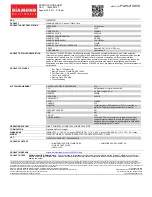
Glossary
|
|
ELSA GLADIAC 5II
|
38
EN
쎲
Buffer swapping –
The image prepared
in the
is displayed.
쎲
Bump mapping –
A technique that pro-
vides textures with depth information,
which can be applied to display relief or
embossed structures.
쎲
Bus system –
A system of parallel con-
ductors for transferring data between indi-
vidual system components, especially to
expansion cards, such as ISA
쎲
Chrominance –
Color information in the
transfer of video signals.
쎲
Clipping –
Reduces the number of
s to be calculated. All primitives
outside the limits of the screen (2D) or out-
side of the
(3D) are
clipped or removed.
쎲
Composite video –
A method of trans-
ferring video data signals, where the sig-
nals for
are combined (also called FBAS).
쎲
Cube environment mapping –
In order
to represent realistic and undistorted re-
flections of the environment onto an ob-
ject, six
s are viewed as the sur-
faces of a cube. The textures show the
environment from the perspective of the
object. This gives the impression that the
environment is being reflected by the
object. CEM is an extension of sphere en-
vironment mapping. The advantage of
CEM is that no new textures need to be
calculated when the observer's point of
view changes and the texture is not dis-
torted.
쎲
D/A converter –
Digital/analog convert-
er: A signal converter that converts digital
input to analog output.
쎲
DDC –
Abbreviation for Display Data
Channel. A special data channel through
which a DDC-capable monitor can send its
technical data to the graphics board.
쎲
Direct3D –
Software interface (
)
developed by Microsoft for the manipula-
tion and display of 3D content.
쎲
DirectColor –
Method to achieve the
high-resolution
,
graphics modes. In
this case, the value stored in the video
RAM (
) is not translated but is
passed directly to the D/A converter
. This means that the full color
information must be saved for each
쎲
DirectDraw –
Software interface (
) developed by Microsoft for the dis-
play of 2D content such as videos.
쎲
Double buffer –
Describes the presence
of doubled display memory. This permits
the next image to be generated first in the
invisible background (
). As
soon as it is completely constructed, the
monitor display switches to the image that
has been residing in the background and
the preparation of the next image begins
on the other side.
쎲
DPMS –
Abbreviation for
Dis-
play Power Management Signaling. This
allows several stages of monitor power
saving mode. The graphics boards
described in this manual support VESA
DPMS.









































